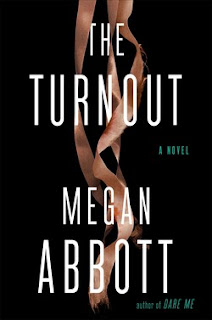By Megan Abbott
G.P. Putnam’s Sons 2021
352 pages Thriller
It has been several days since I finished reading The
Turnout by Megan Abbott, and the book is still haunting me! Abbott
writes, “Ballet was full of dark fairy tales.” And for Marie and Dara Durant
the fairy tale darkness comes true as they prepare their young ballet students
for this year’s coming production of the Nutcracker. Marie, Dara, and
Dara’s husband Charlie run the school that the girls’ mother started in the
1980s. Charlie was a dancer, but because of a variety of injuries, he can no longer dance. The three live in the
same house that the family has owned for years and teach in the building that
has been the studio since the beginning. This is the foundation for the "dark fairy tales."
Marie is at odds with her sister and husband and has moved
to the attic of the studio to live. The heater she is using causes a fire which
burns one of the studios just as the Nutcracker practices begin in
earnest. The insurance agent recommends Derek, a local contractor, to do the
repairs, and Derek invades the space, the lives, and the minds of Marie, Dara,
and Charlie. Tension builds, illusions are shattered, and lives are destroyed.
While there is no murder to solve, the plot is surprisingly propulsive. Abbott knows a lot about ballet, and while the main plot concerns the relationship between the ballet studio owners and Derek, the contractor, the sub-plot of putting together the Nutcracker ballet with all the tryouts, the practices, the pre-teen girl drama, the injuries, and the costuming is enlightening and repulsive at the same time. I don’t believe that I will ever look at ballet lessons and/or The Nutcracker with the same eyes again. One reviewer notes, “For all its beauty, ballet can be born out of pain.” Abbott explores that concept relentlessly, and the reader moves from fond childhood Nutcracker memories to visions of turned ankles, spiteful girls, and unraveled dreams.
Last week, I had a timeout trip to the family cottage on
Lake Michigan. The Turnout was the book I took with me to read. I
knew it had been well reviewed, and I felt that it would be an excellent
respite book. I was in and out of the house all day and took several walks—every
time the tension in the book got to be more than I could stand. It was about
10:30 at night when other family members arrived. According to my Kindle I was
97% through the book. How dare they come when I was this close to getting some
final closure on the horrifying events! I excused myself as quickly as I could
and retreated to my bedroom to bring the whole sordid affair to the end.
Here is a fascinating interview with Megan Abbott on the Book
Page website.
Just published, The Turnout is on many lists
of the best books of summer 2021.








